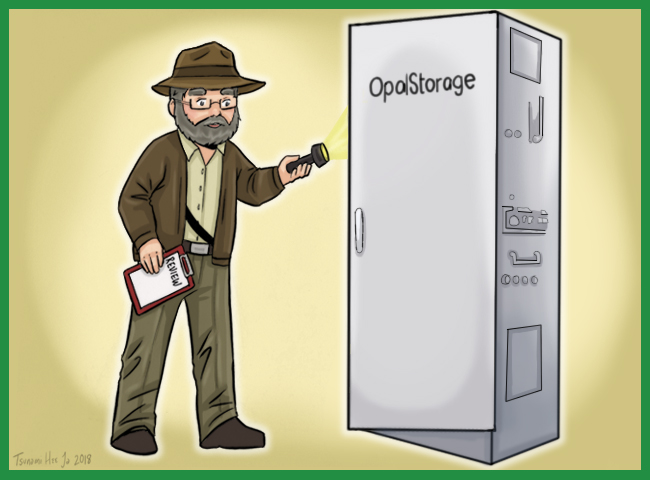
Professor of Archaeology, expert on the occult, and how does one say it… reviewer of steel battery boxes.
Opal Solar is a brand owned by the Australian solar wholesaler Solar Juice. Last December they launched Opal Storage, an “all-in-one” home battery system.Opal Storage comes with full backup ability1 and in two different sizes, with the larger one costing around $12,000. For that you get:
- A SolaX SK-TL5000E 4.6 kilowatt multimode inverter.
- A SolaX Battery Management Unit.
- 2 LG Chem modular batteries with a total nominal capacity of 13 kilowatt-hours. With a 90% depth of discharge they will provide 11.7 kilowatt-hours of usable storage. Depth of discharge can be set to a maximum of 95% which will give 12.35 kilowatt-hours of usable storage, but Opal Solar / Solar Juice recommend depth of discharge be set no lower than 92% to 93%.
- A metal cabinet to keep all these goodies inside and out of harm’s way.
The smaller version is identical except it has one one modular battery instead of two (half the capacity) and is likely to cost around $2,500 to $3000 less. These price estimates don’t include the cost of installation, but Opal Solar / Solar Juice make a big deal about how easy it is to install, so hopefully that won’t be too much.
If you’re installing a new solar power system then you only need to add the cost of panels and installation because the Solax multimode inverter is a solar inverter and battery inverter in one. And if your old inverter has died or if you want to replace one that’s on its last legs, you could potentially rewire your panels into the Solax Inverter2.
If you’re an energy storage aficionado and have home battery system datasheets instead of pinups on your walls3, you may have noticed the Opal Storage cabinet looks exactly the same as that of the SolaX Power Station. This is because it is exactly the same cabinet except for the name. SolaX and Solar Juice worked together to design it. The two systems are almost identical and you can use our battery comparison table to check out their differences.
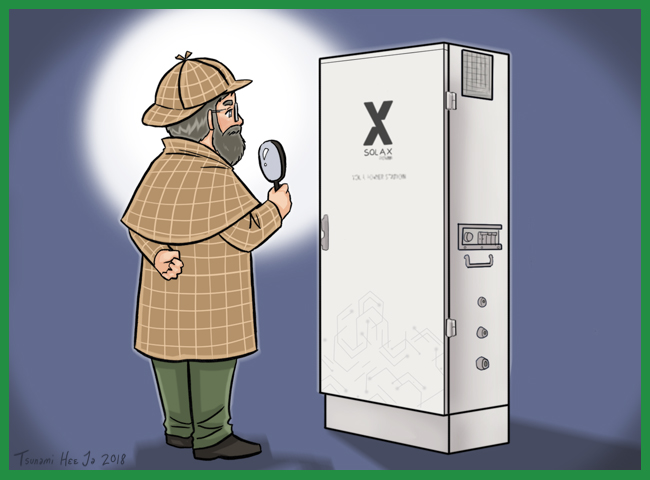
Hmmm. This looks familiar…
The Opal Storage system’s SolaX inverter is rated at 4.6 kilowatts under normal operation, but in a blackout is limited to 4 kilowatts. This is enough for a typical family to run lights, refrigeration, TVs, computers, and an air conditioner, but they’d have to avoid or be careful with the use of high draw appliances such as electric stoves, clothes dryers, and electric heaters. The smaller capacity system is only rated at 3 kilowatts of battery power at any time.
Warranties for the Opal Storage are a little confusing as different components have different warranties:
- SolaX inverter and battery management unit — A 5 year warranty that can be extended.
- LG Chem batteries — 10 years or, for the larger version, until it provides 40,000 kilowatt-hours of storage. You’ll need to draw under 10 kilowatt-hours per day, on average for it to last the full 10 years
- Metal Cabinet — 1 year warranty
Solar Juice tells me they sold over 100 units in the two months following its launch. While they had difficulty meeting demand at first, they have increased production and systems can now be purchased without a waiting period.
Movie Time
Here’s a video of Solar Juice’s Business Development Manager and the General Manager of SolaX introducing Opal Storage and showing what’s inside the case.
Raiders Of The Opal Brochure
I have rifled through the Opal Storage brochure to bring you highlights from the tables it contains. But if you want all the information straight from the horse’s mouth4 you can check it out in full here.
General Data
General Data is Lieutenant Commander Data after a big promotion. In this particular case it’s also general information about the Opal Storage system:
Size & Weight: At 75 cm across, 41 cm deep, and 155 cm high the Opal Storage is two-thirds the total volume of my 350 liter fridge but is wider and not as deep.
The table gives the weight of the empty cabinet, which is useful for people who have to lug it into place, but I’m guessing you’d be more interested in knowing that the entire system comes to around 240 kg.
Installation Location: The Opal Storage system has an Ingress Protection rating of IP54 which means it can be installed outdoors. It is protected against rain but it’s not a good idea to use a high pressure hose to wash cobwebs off it.
Monitoring: The system can be monitored online through ‘Opal View’.
Reposit Ready: If you pay to have Reposit installed you can instead monitor it through the Reposit app. If you want to know what Reposit is, I wrote this article about it.
The Batteries
The massive South Korean company LG Chem make the batteries. They are modular, rack-mounted, and the bigger system has two of them.
Battery Capacity: When new, the 2 batteries can store 13 kilowatt-hours if 100% discharged. But that’s not good for their health so the Opal Storage system is configured with a maximum depth of discharge of 95%. If you want to go easy on your batteries and presumably extend their lifespan you can restrict that to 80% depth of discharge. The usable storage capacity at various depths of discharge for the larger system5 are:
- 100% depth of discharge (Not permitted) — 13 kilowatt-hours
- 95% depth of discharge (maximum allowed) — 12.35 kilowatt-hours
- 93% depth of discharge (maximum recommended) — 12.1 kilowatt-hours
- 90% depth of discharge (figure used in our Battery Comparison Table) — 11.7 kilowatt-hours
- 80% depth of discharge — 10.4 kilowatt-hours
Unfortunately these capacities are only for when the Opal Storage’s batteries are new. They will gradually decline with time and use. Their warranty promises they will still have at least 60% of their original capacity by its end. The battery warranty is not affected by the depth of discharge configured.
Round-Trip Efficiency: The round-trip efficiency of 95% in the table is just for the batteries. Energy will also be lost in the inverter. I do not have a round trip efficiency figure for the entire system but the SolaX inverter is around 97% efficient and, assuming a 2% loss when converting DC to a lower voltage for battery charging, then the total round trip efficiency of the system would be around 90%. Personally though, I’d expect it to be a little less6. That’s just the way the efficiency cookie seems to crumble. It generally crumbles at least 11%.
Operating Temperature: The battery operating temperature is -10 to 45ºC, a reasonable range for Australia. But the inverter will derate once the ambient air temperature goes above 40ºC . This means the maximum amount of inverter output power will decline whether that power comes from solar panels or batteries or both. It’s likely to be only 75% by the time the temperature reaches 45ºC and the system disables the batteries. It can continue to give power from the solar panels until the temperature reaches 50ºC by which point it’s likely to be derated to just 50%.
Inverter And Battery Management Unit
Here’s some information on the inverter and battery management unit squished together in one table:
Inverter Power On & Off Grid: When on-grid the inverter can supply a maximum of 4.6 kilowatts of power from the batteries and/or solar panels for the larger system. During a blackout this will fall to 4 kilowatts. The smaller Opal Storage system can only provide a maximum of 3 kilowatts of battery power at any time.
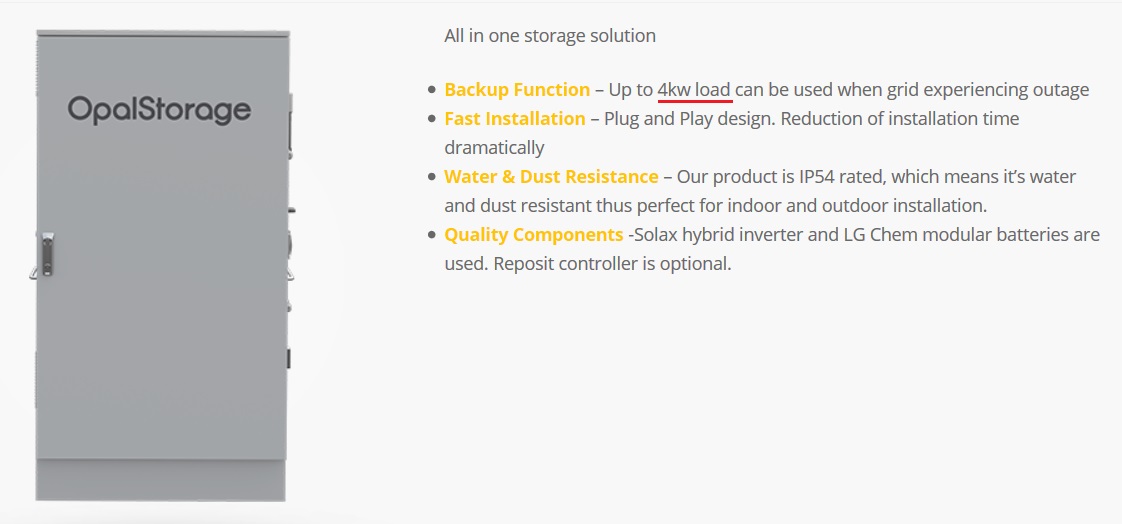
From this Solar Juice page. (I added the red underline.)
Three or four kilowatts is enough power to allow most homes to operate but you’d have to be careful not to use too many high power consumption appliances at once. For example, an electric stove can easily draw more than four kilowatts of power if enough elements are on.
Interesting Information From The Opal Solar Site
The following screenshot I took from the Opal Solar home page is a very good example of why it is vital to do your own research into the economics of batteries before buying:
It gives estimated annual savings of $2,700 for the larger system and half that for the smaller. A little lower on this page it gives this information:
Looking at the figures they’ve given I see they are claiming that if the larger Opal Storage system:
- discharges 12.33 kilowatt-hours every day for a year
- only during a peak period when the cost of electricity is 60 cents a kilowatt-hour
then it will save a household $2,700 on electricity bills.
But there are many problems with these assumptions and the resulting calculation:
- Very few people have a time-of-use tariff with a peak rate of 60 cents per kilowatt-hour.
- Peak tariffs only apply 5 days a week, not 7, so what they have assumed is impossible.
- It assumes the electricity used to charge the batteries costs nothing. Solar Juice have forgotten that charging with solar electricity forgoes the feed-in tariff 7.
- Normal households don’t use battery storage in this way.
- They only count savings on a time-of-use tariff but most solar households are better off on a standard tariff. What they would be paying with a standard tariff will determine the actual savings.
- While they are clearly not considering capital costs in their estimate, they definitely should be taken into account when determining if batteries will pay for themselves.
I believe a potential customer could see the above estimate, perhaps someone in Sydney who is paying 60 cents per kilowatt-hour during peak periods, and conclude they will save that much money if they install an Opal Storage system. They would end up very disappointed if their electricity consumption is at all normal.
The good news is I have talked to Opal Solar / Solar Juice about the problems with their estimate and they have said they will change it. So they should be advertising more realistic estimated savings for the Opal Storage soon. I’ll be keeping an eye out for that.
Warranties
The Opal Storage system has three separate warranties.
- The inverter and Battery Management Unit are warranted for 5 years by SolaX.
- The LG Chem batteries have a partial warranty for up to 10 years provided by SolaX.
- The metal cabinet and components inside has a 1 year warranty provided by Opal Solar.
5 Year Inverter & BMU Warranty
The SolaX inverter and Battery Management Unit come with a standard 5 year warranty but you can pay to extend it to 10 years. This is likely to cost over $300. It can be further extended, all the way to 20 years, but you’d want to think carefully if the extra cost is worth it.
Their Australian warranty is not available on the SolaX site. Fortunately, one can be downloaded from Solar Juice here.
Up To 10 Year Partial Battery Warranty
Solax warrant the LG Chem batteries for either 10 years, or until they have provided 40,000 kilowatt-hours of storage8; whichever comes first. The good news is the warranty is likely to last for the full 10 years for almost everyone as most households only draw around 80% of their battery’s usable capacity per day.
Reposit say people who use their battery management system will draw over an average of over 100% of usable capacity per day, up to 130%. So if a person averaged 110% of usable storage per day by occasionally charging it with grid electricity, then with a 90% depth of discharge and no battery deterioration their warranty would last for 8.5 years. The good news/bad news is that with declines in battery capacity over time it would be likely to last around the full 10 years.
The warranty only promises the batteries will retain 60% of their original capacity by its end. If they degrade down to that level they will only be able to provide 7 kilowatt-hours of usable storage with a 90% depth of discharge.
If the battery fails under warranty SolaX can replace it with either new or used batteries. If they are no longer available they can choose to give you either an equivalent battery or a refund. But they won’t give you are full refund or even a pro rata9 one. Instead they have the following screw-over scheme laid out:
So if your batteries failed just after 7 years and you’d only used 70% of warranted total storage then SolaX says they only need to refund you 6% of what you paid. While I think batteries will continue to rapidly fall in price, I don’t think they’ll fall that fast. Battery capacity that costs $100 today is not going to cost $6 in seven years time.
[Update 28th of March: I originally wrote 6 years instead of 7 years above. Thanks to Pietro Pinna for pointing out my mistake in the comments.]
Fortunately you are protected by Australian Consumer Guarantees that apply regardless of what is in a written warranty and you can use them to make a claim for a proper remedy and not just a refund of a few percent.
1 Year Metal Cabinet Warranty
Opal Solar warrant the metal cabinet for only one year. This seemed like an odd length to me. After all, what’s likely to go wrong with a big metal box in such a short period? I inquired about this and was told many of the components in the Opal Storage box only have manufacturers’ warranties of one year. So it’s not just a metal box, it contains cables, connectors, isolators, and other components. Despite this I still believe the warranty is too short.
Manufacturers generally give electrical and electronic components a short warranty because they don’t know how they will be used. But nothing in that box should be badly abused. I’m confident Opal Solar / Solar Juice designed it well and nothing is likely to rapidly fall apart or disintegrate. Maybe they are concerned about teething problems and intend to increase the warranty later when they are confident it all works well. But if they took more of that risk on themselves I’m sure it would help sales, as I know I wouldn’t be happy with a one year warranty.
Update: When this article was first published it mistakenly said the battery warranty for the larger Opal Storage only covered 10 years or 20,000 kilowatt-hours of storage but the actual amount is 40,000 kilowatt-hours and it is 20,000 for the smaller version. Fortunately my mistake was very quickly pointed out to me and it has been corrected.
Footnotes
- During grid-outages it can charge its batteries from your solar panels – but it is not designed for full off grid use ↩
- Assuming that 1) your solar panels are modern enough that they meet the latest Australian Standards and 2) your original installer will still honour the panel warranty – which under Australian Consumer Law he probably should – but he may need some convincing. ↩
- Please seek help. You have a shocking problem. ↩
- Eww! ↩
- For the small system the battery capacity will be half those amounts. ↩
- The efficiency figure I have for the SolaX inverter would be for inverting higher voltage DC from the panels. I don’t have an efficiency figure for inverting the lower voltage DC from the batteries. ↩
- and if you are charging off-peak, electricity retailers charge money for off-peak electricity ↩
- For the larger system. Half this for the smaller system ↩
- Pro rata means the warranty is proportional, so if you got 60% of the use promised by the warranty they’ll refund you 40% of what you paid. ↩

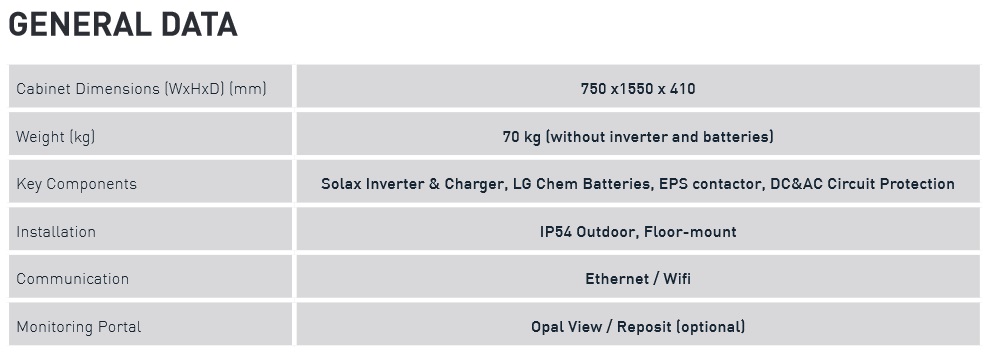


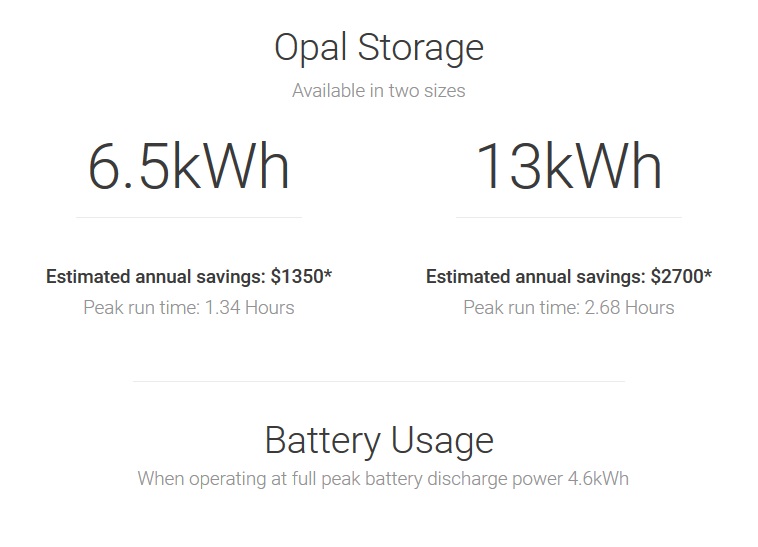


 RSS - Posts
RSS - Posts



The savings are more than optimistic
.the easy way is look at your power bill add it add the feed back that you won’t get.Final figure is your saving.
In my case equals ,
1,500.00 AU
Good one Ronald. It’s sad that people are still trying to sell impossible bill savings from batteries. If you’re spending over $10k on a solar system, it would make sense to get a proper analysis/simulation done on your likely realistic bill savings…
I have just installed my 2 kW wind turbine from Auswind with 16 batteries Gel cells rated at 170 Amp Hours in 4 sets of 4 at 48 VDC and Inverter rated at 6000 watts continuous The whole setup cost me $12300 all up and will run my home for 8 to 10 hours without wind.. With a total of 680 AH at 48 VDC Used my welder practically all day and voltage did not drop below 51 volts.\
With my last lot of gel cells lasting over 9 years I think they are still much better value than the new fangled batteries at stupid prices.
Hi Antonius,
Can you send us a picture? ([email protected])
I’m guessing you live out of town and it is on a very high pole?
Finn
Gee, it’s a minefield buying into battery storage systems, what one is best for what price point and what do you do with the power company etc etc….
I really would no have any idea what so ever of what one to get for what I want now reading all the articles I’ve read on here. Don’t get me wrong, you do a great job of looking at all the different units and that is appreciated very much, but it’s made me rethink even looking at any at the moment as I really don’t know what I want for battery storage.
if they failed after 6 years that is 16% not 6% based off the table.
Thank you Pietro for pointing that out. That should have been seven years, not six. I have corrected my mistake in the article.
How will the pending time of day tarrifs for Victoria affect battery economics?
That is something I could look into in detail, but the short answer for now is it won’t enable batteries to pay for themselves yet.